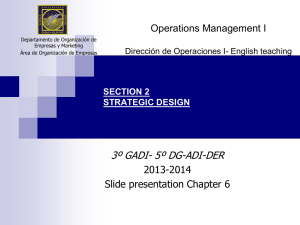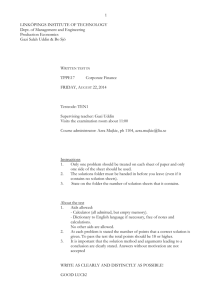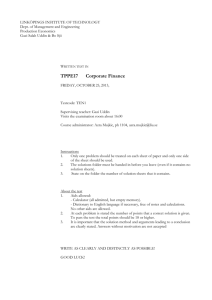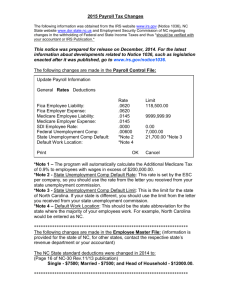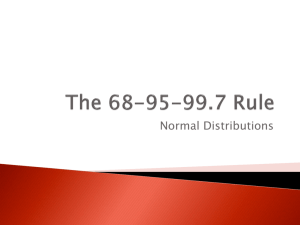Chapter 6 – Capacity Planning
advertisement
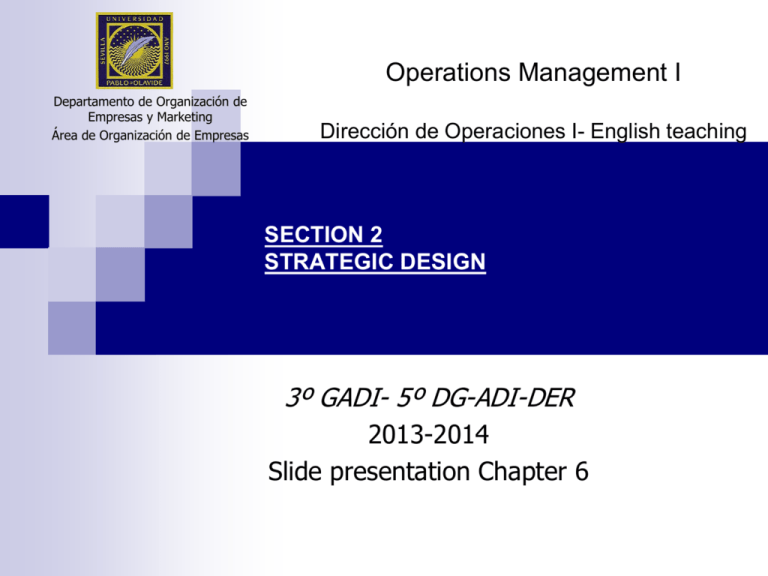
Operations Management I Departamento de Organización de Empresas y Marketing Área de Organización de Empresas Dirección de Operaciones I- English teaching SECTION 2 STRATEGIC DESIGN 3º GADI- 5º DG-ADI-DER 2013-2014 Slide presentation Chapter 6 CHAPTER 6 CAPACITY PLANNING 6.1. 6.2. 6.3. 6.4. Capacity Measurement Long-Term Capacity Strategies Short-Term Capacity Strategies Break-Even Analysis: Comparison of Alternatives 2 6.1 Capacity The throughput, or the number of units a facility can hold, receive, store, or produce in a period of time Determines a large proportion of fixed costs Determines if demand will be satisfied or facilities idle Three time horizons 3 Planning Over a Time Horizon Long-range planning Add facilities Add long lead time equipment Intermediaterange planning Subcontract Add equipment Add shifts Short-range planning Add personnel Build or use inventory * Modify capacity * Schedule jobs Schedule personnel Allocate machinery Use capacity * Limited options exist 4 6.1 Capacity Capacity decisions are often influenced by economies and diseconomies of scale: Economies of scale are achieved when the average unit cost of a good or service decreases as the capacity and/or volume of throughput increases Diseconomies of scale occur when the average unit cost of the good or service begins to increase as the capacity and/or volume of throughput increases. 5 Average unit cost (dollars per room per night) Economies and Diseconomies of Scale 25 - Room Roadside Motel 50 - Room Roadside Motel Economies of scale 25 75 - Room Roadside Motel Diseconomies of scale 50 Number of Rooms 75 6 Design and Effective Capacity Design capacity is the maximum theoretical output of a system in a given period under ideal conditions Normally expressed as a rate Effective capacity is the capacity a firm expects to achieve given current operating constraints Often lower than design capacity Safety capacity (or capacity cushion) is defined as an amount of capacity reserved for unanticipated events such as demand surges, materials shortages, and equipment breakdowns 7 Utilization and Efficiency Utilization is the percent of design capacity achieved Utilization = Actual Output/Design Capacity Efficiency is the percent of effective capacity achieved Efficiency = Actual Output/Effective Capacity 8 Bakery Example Actual production last week = 148,000 rolls Effective capacity = 175,000 rolls Design capacity = 1,200 rolls per hour Bakery operates 7 days/week, 3 - 8 hour shifts Design capacity = (7 x 3 x 8) x (1,200) = 201,600 rolls Utilization = 148,000/201,600 = 73.4% Efficiency = 148,000/175,000 = 84.6% 9 Capacity Considerations Forecast demand accurately Understanding the technology and capacity increments Find the optimal operating level (volume) Build for change 10 Managing Demand Demand exceeds capacity Curtail demand by raising prices, scheduling longer lead time Long term solution is to increase capacity Capacity exceeds demand Stimulate market Product changes Adjusting to seasonal demands Produce products with complimentary demand patterns 11 Complementary Demand Patterns Sales in units 4,000 – By combining both, the variation is reduced 3,000 – Snowmobile sales 2,000 – 1,000 – Jet ski sales JFMAMJJASONDJFMAMJJASONDJ Time (months) 12 6.2 Long-Term Capacity Strategies Firms must anticipate growth or decline in demand and plan capital investments Complementary goods and services: goods and services that can be produced or delivered using the same resources available to the firm, but whose seasonal demand patterns are out of phase with each other Design higher levels of self-service (customer labor) into operations 13 Approaches to Capacity Expansion Expected demand Demand (c) Capacity lags demand with incremental expansion New capacity Expected demand Demand New capacity (b) Leading demand with one-step expansion New capacity Expected demand (d) Attempts to have an average capacity with incremental expansion Demand Demand (a) Leading demand with incremental expansion New capacity Expected demand 14 6.3 Short-Term Capacity Strategies Managing Capacity by Adjusting ShortTerm Capacity Levels Add or share equipment Sell unused capacity Change labor capacity and schedules Change labor skill mis Shift work to slack periods 15 6.3 Short-Term Capacity Strategies Managing Capacity by Shifting and Stimulating Demand Vary the price of goods or services Provide customers information Advertising and promotion Add peripheral goods and/or services Provide reservations (a promise to provide a good or service at some future time and place) 16 6.4. Break-Even Analysis: Comparison of Alternatives A means of finding the point at which costs equal revenues Assumptions: Only one product Everything produced is sold Cost and revenue are linear functions Constant price sale and variable cost. Clear differentiation between fixed and variable costs Fixed costs: costs that continue even if no units are produced Variable costs: costs that vary with the volume of units produced Contribution: difference between selling price and variable costs 17 6.4 Break-Even Analysis: Comparison of Alternatives Total revenue: TR = P x P = price per unit Total cost: TC = V x + F x = number of units produced (or demand) Benefits: B = P x - (V x + F) V= variable cost per unit BEP = F / (p - V) F= fixed costs Graphic approach B (u.m) Alt. B Alt. A D < BEP_A Do nothing BEP_A D < X1 BEP_A X1 FA BEP_B FB X (units) Alt. A D = X1 Indifferent D > X1 Alt. B 18 6.4 Break-Even Analysis: Comparison of Alternatives RANDOM DEMAND: • Discrete probability Demand Expected levels Probability Benefit Xo Po Bo X1 P1 B1 .... ..... ..... Xm Pm Bm ..... ..... ..... Xn Pn Bn demand and benefit n DE = xiPi i 1 n n i 1 i 1 BE = BiPi [( p Cv) xi CF]Pi n Pi 1 i 1 19 6.4 Break-Even Analysis: Comparison of Alternatives Áreas bajo la curva normal estándar. Los valores de la tabla que no se muestran en negrita representan la probabilidad de observar un valor menor o igual a z. La cifra entera y el primer decimal de z se buscan en la primera columna, y el segundo decimal en la cabecera de la tabla. •Continuous probability: B = P x - (V x + F)= P x - V x - F = (P - V) x - F P (B > Bmín) = P[(P-V) x - F > (P-V) xmín - F = Since P, V and F are constant = P(x > xmín) = 1 - P(x xmín) Standarizing the variable xmín x ~ N(µ, ) P (B > Bmín) = 1 - P (Z Zmín= (xmín - µ )/) z 0.0 0.1 0.2 0.3 0.4 0.5 0.6 0.7 0.8 0.9 1.0 1.1 1.2 1.3 1.4 1.5 1.6 1.7 1.8 1.9 2.0 2.1 2.2 2.3 2.4 2.5 2.6 2.7 2.8 2.9 3.0 3.1 3.2 3.3 3.4 3.5 3.6 3.7 3.8 3.9 0 .5000 .5398 .5793 .6179 .6554 .6915 .7257 .7580 .7881 .8159 .8413 .8643 .8849 .9032 .9192 .9332 .9452 .9554 .9641 .9713 .9772 .9821 .9861 .9893 .9918 .9938 .9953 .9965 .9974 .9981 .9987 .9990 .9993 .9995 .9997 .9998 .9998 .9999 .9999 1 Segunda 1 2 .5040 .5080 .5438 .5478 .5832 .5871 .6217 .6255 .6591 .6628 .6950 .6985 .7291 .7324 .7611 .7642 .7910 .7939 .8186 .8212 .8438 .8461 .8665 .8686 .8869 .8888 .9049 .9066 .9207 .9222 .9345 .9357 .9463 .9474 .9564 .9573 .9649 .9656 .9719 .9726 .9778 .9783 .9826 .9830 .9864 .9868 .9896 .9898 .9920 .9922 .9940 .9941 .9955 .9956 .9966 .9967 .9975 .9976 .9982 .9982 .9987 .9987 .9991 .9991 .9993 .9994 .9995 .9995 .9997 .9997 .9998 .9998 .9998 .9999 .9999 .9999 .9999 .9999 1 1 cifra decimal del valor de z 3 4 5 6 7 .5120 .5160 .5199 .5239 .5279 .5517 .5557 .5596 .5636 .5675 .5910 .5948 .5987 .6026 .6064 .6293 .6331 .6368 .6406 .6443 .6664 .6700 .6736 .6772 .6808 .7019 .7054 .7088 .7123 .7157 .7357 .7389 .7422 .7454 .7486 .7673 .7704 .7734 .7764 .7794 .7967 .7995 .8023 .8051 .8078 .8238 .8264 .8289 .8315 .8340 .8485 .8508 .8531 .8554 .8577 .8708 .8729 .8749 .8770 .8790 .8907 .8925 .8944 .8962 .8980 .9082 .9099 .9115 .9131 .9147 .9236 .9251 .9265 .9279 .9292 .9370 .9382 .9394 .9406 .9418 .9484 .9495 .9505 .9515 .9525 .9582 .9591 .9599 .9608 .9616 .9664 .9671 .9678 .9686 .9693 .9732 .9738 .9744 .9750 .9756 .9788 .9793 .9798 .9803 .9808 .9834 .9838 .9842 .9846 .9850 .9871 .9875 .4878 .9881 .9884 .9901 .9904 .9906 .9909 .9911 .9925 .9927 .9929 .9931 .9932 .9943 .9945 .9946 .9948 .9949 .9957 .9959 .9960 .9961 .9962 .9968 .9969 .9970 .9971 .9972 .9977 .9977 .9978 .9979 .9979 .9983 .9984 .9984 .9985 .9985 .9988 .9988 .9989 .9989 .9989 .9991 .9992 .9992 .9992 .9992 .9994 .9994 .9994 .9994 .9995 .9996 .9996 .9996 .9996 .9996 .9997 .9997 .9997 .9997 .9997 .9998 .9998 .9998 .9998 .9998 .9999 .9999 .9999 .9999 .9999 .9999 .9999 .9999 .9999 .9999 .9999 .9999 .9999 .9999 .9999 1 1 1 1 1 8 .5319 .5714 .6103 .6480 .6844 .7190 .7517 .7823 .8106 .8365 .8599 .8810 .8997 .9162 .9306 .9429 .9535 .9625 .9699 .9761 .9812 .9854 .9887 .9913 .9934 .9951 .9963 .9973 .9980 .9986 .9990 .9993 .9995 .9996 .9997 .9998 .9999 .9999 .9999 1 9 .5359 .5753 .6141 .6517 .6879 .7224 .7549 .7852 .8133 .8389 .8621 .8830 .9015 .9177 .9319 .9441 .9545 .9633 .9706 .9767 .9817 .9857 .9890 .9916 .9936 .9952 .9964 .9974 .9981 .9986 .9990 .9993 .9995 .9997 .9998 .9998 .9999 .9999 .9999 1 20 6.4 Break-Even Analysis: Comparison of Alternatives PROBLEM 1: NORTEL Inc. is opening a new plant in Malaga. They have to decide regarding the capacity of the new plant between the following alternatives: Size Annual Capacity Fixed Costs Unit Variable Costs Selling Price Big 7.000 1.800.000 1.500 2.000 Medium 5.000 1.200.000 1.600 2.000 Small 2.500 740.000 1.700 2.000 With the information provided we want to determine which is the best option in the following cases: 1º) Using the graphic approach of the break-even analysis. 21 6.4 Break-Even Analysis: Comparison of Alternatives PROBLEM 1 (cont.): 2º) Knowing different demand levels and their probability: Demand (Di) Probability (Pi) 1.000 0,05 2.000 0,15 3.000 0,25 4.000 0,25 5.000 0,15 6.000 0,1 7.000 0,05 3º) Assuming demand is normally distributed with mean 4.000 and standard deviation 1.000, we will choose the alternative with the highest probability of achieving, at least, an expected benefit of 100.000 € 22

